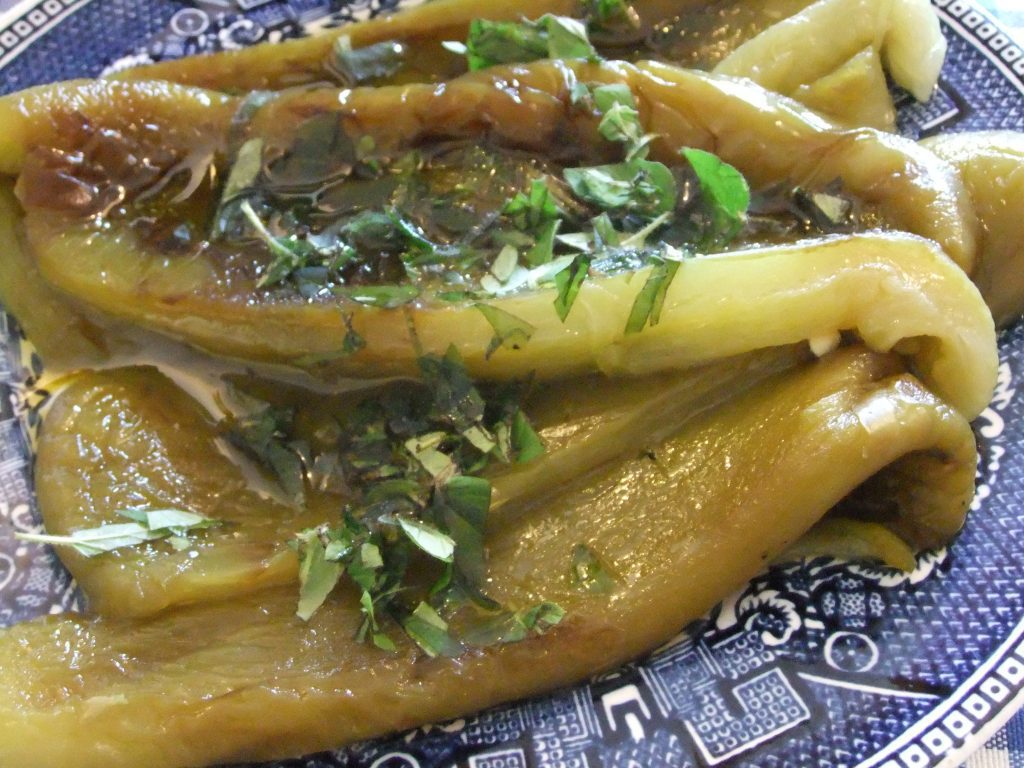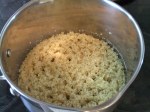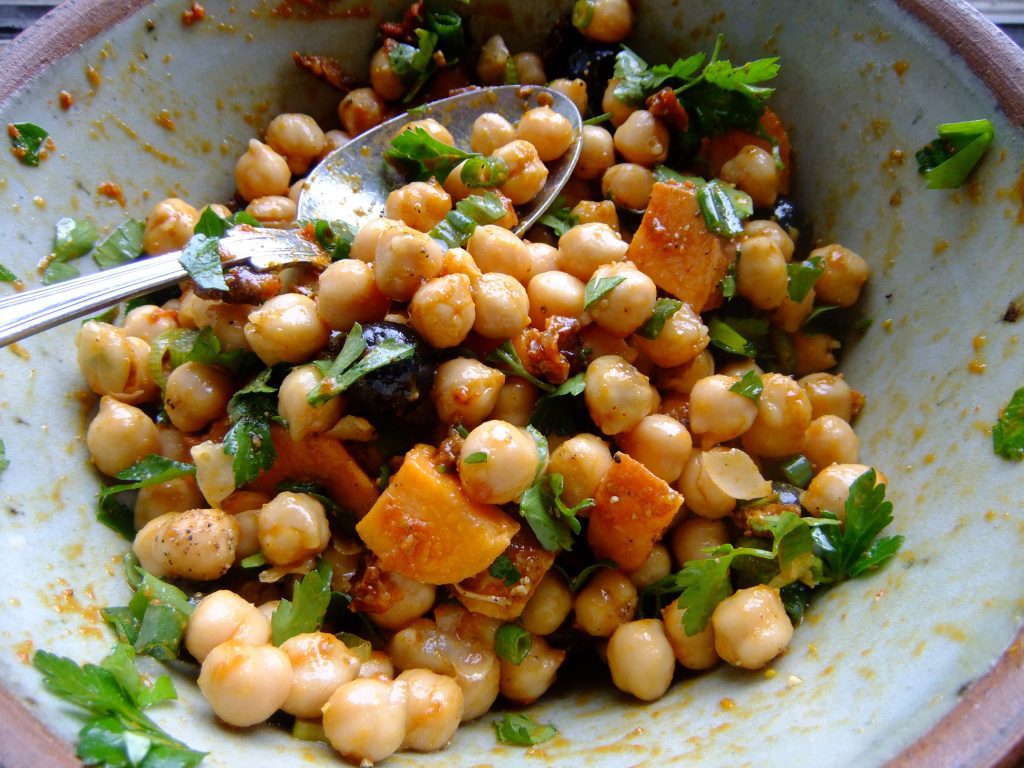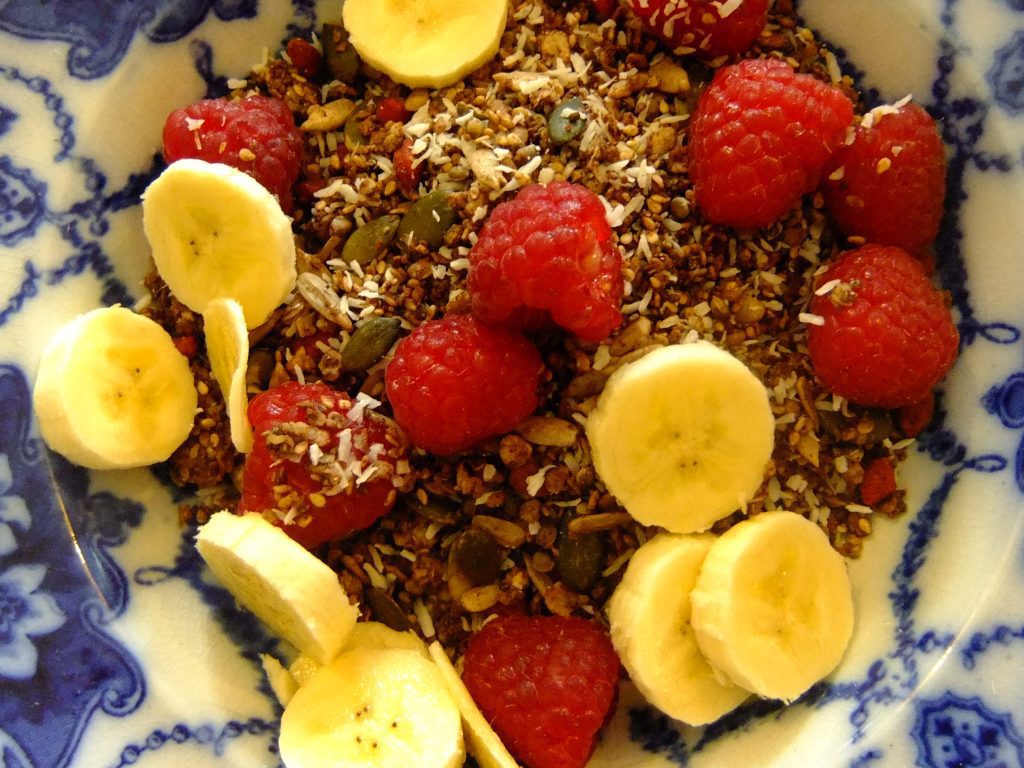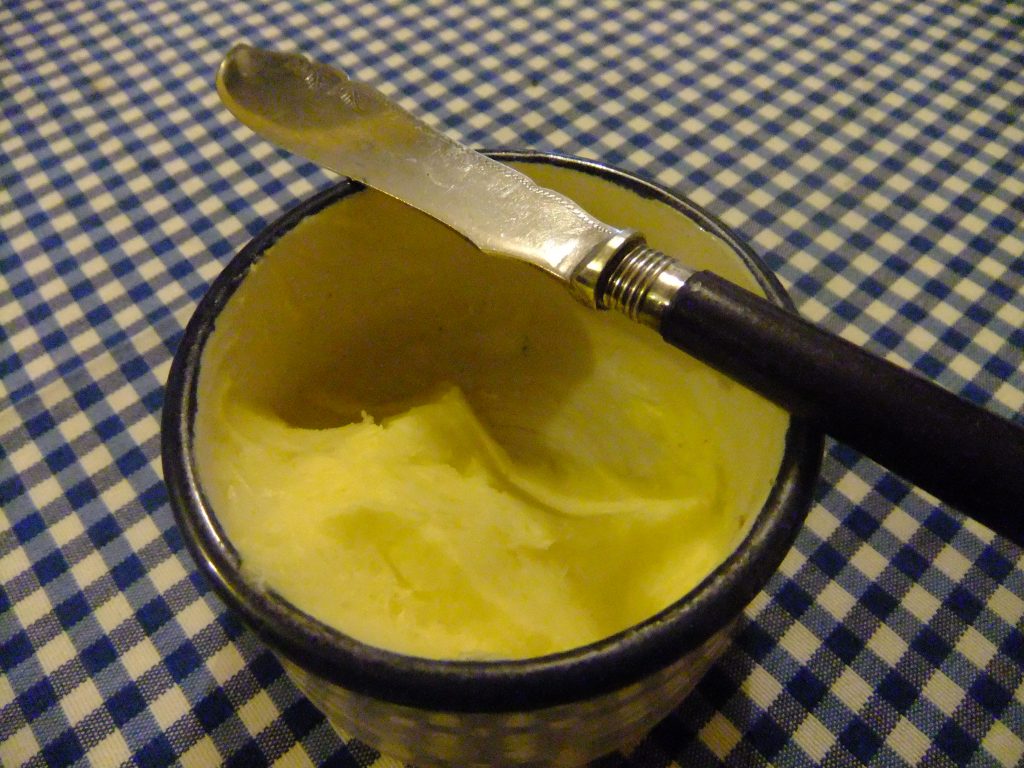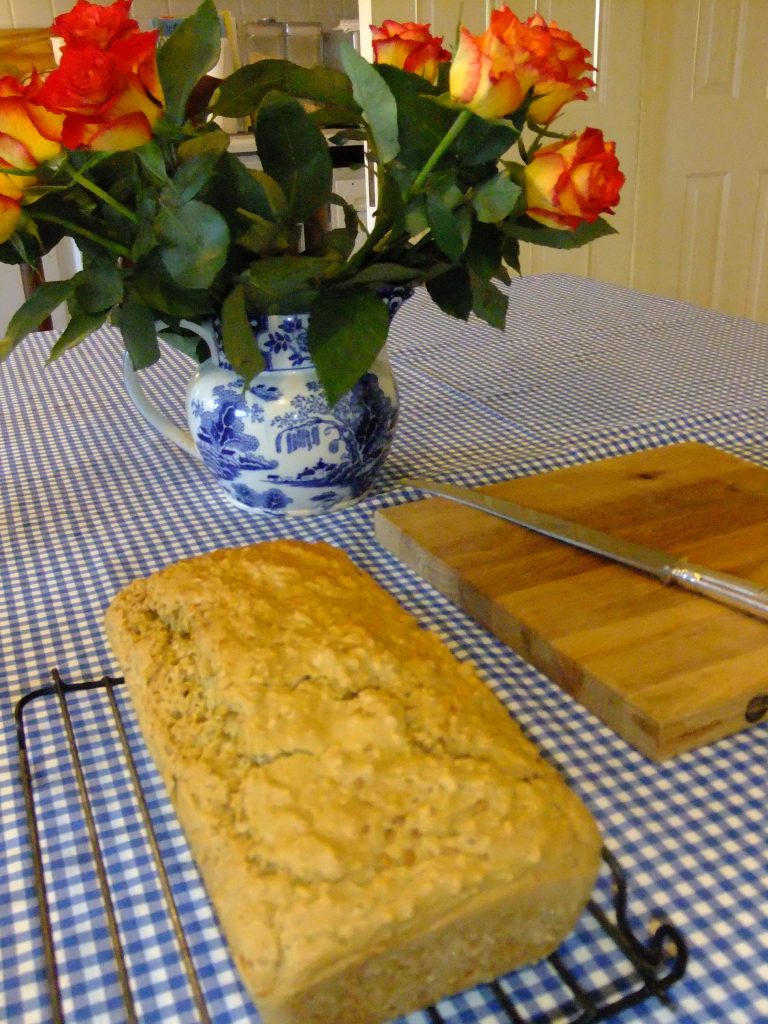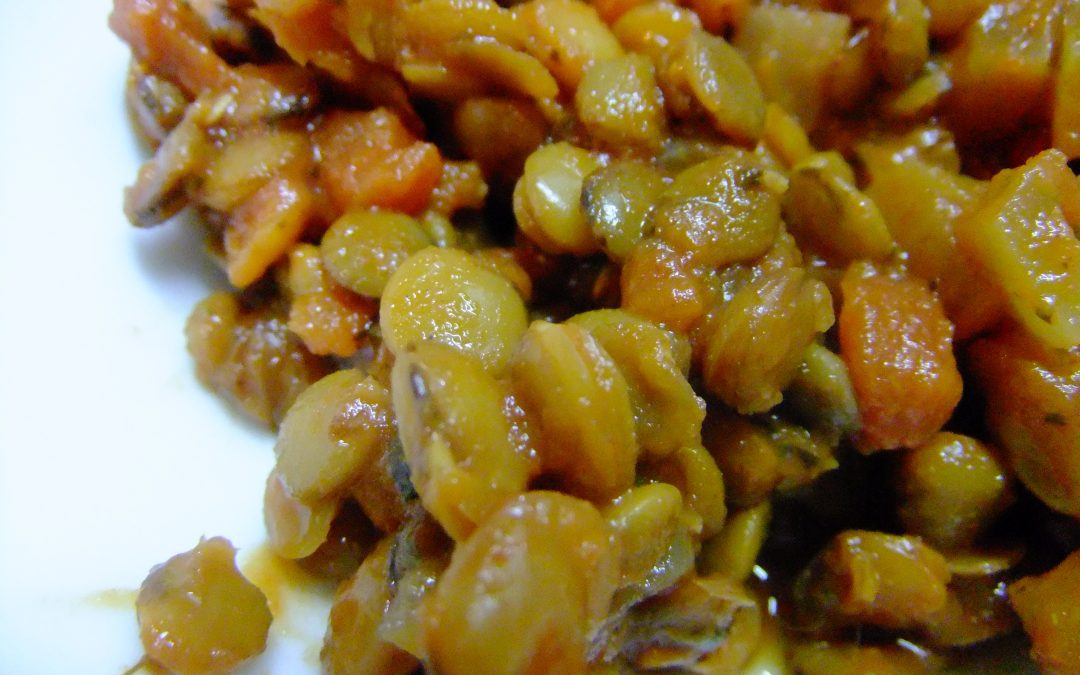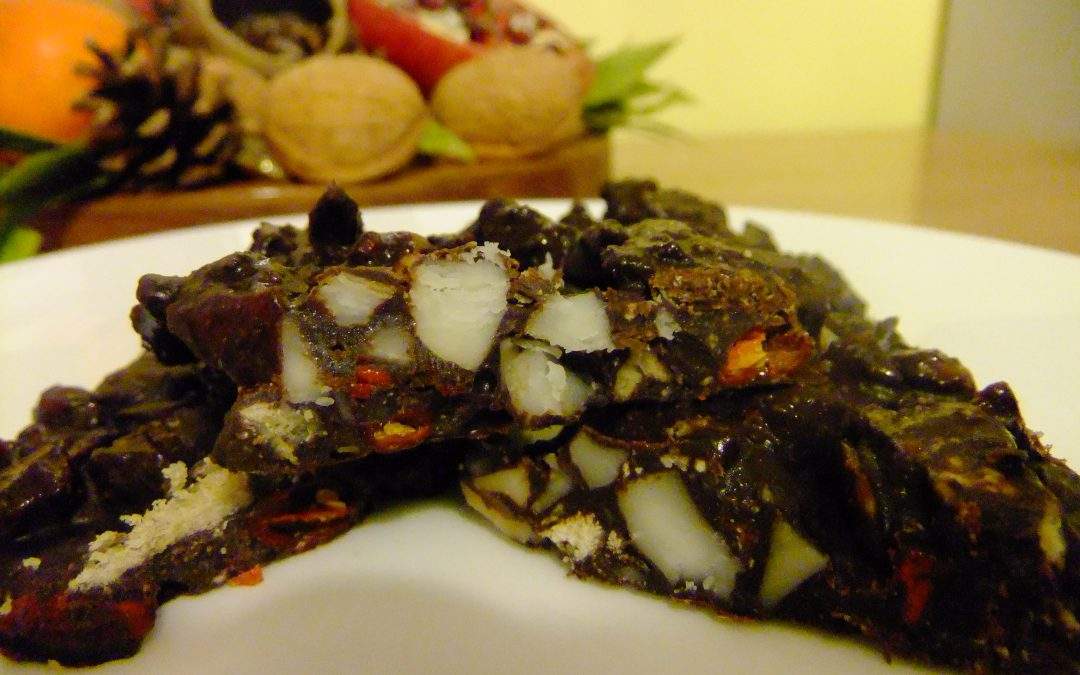
May 21, 2014 | Anna's Best Recipes, Sides, starters, soups & snacks
The good weather got me thinking of this really simple, delicious dish. A Greek classmate once showed me how to make it. She simply charred the peppers in a few minutes over an open gas flame but you can use a grill. This dish works well as a starter with some fresh bread, or as a side dish alongside some meat, grilled/baked white fish or a vegetable frittata. It’s also great for a summer buffet. Using goat or sheep feta gives a lovely crumbly texture and tangy taste and is easier to digest than imitation feta made from cow’s milk.
If you don’t have oregano, you could also use fresh mint or flat leaf parsley.
For 2 people:
2 large green peppers, whole, washed
1 dsp dried oregano or tbsp chopped fresh oregano leaves
1-2 tbs good quality extra virgin olive oil
20g goat/sheep feta cheese
1. Put the green peppers on a baking sheet under a hot and cook (turning frequently) until most of the skin is charred and the peppers are soft and slightly collapsed.
2. Remove from the heat, leave on the baking sheet, and cover with a large bowl or saucepan for 15 minutes or so. This softens the skins and makes them easier to peel.
3. On a plate (to catch the delicious juices) peel and discard the skins of the peppers. Slice into around 4 lengthways. Remove and discard the stalks and anything that’s not green.
4. Lay the peppers with their juices on a fresh plate.
5. Sprinkle over some freshly ground some black pepper and the oregano. Crumble the feta into little pieces and scatter over. Finally, drizzle over the olive oil.
Why this is good for you
Oregano, especially eaten fresh, is a powerhouse of volatile antioxidant rich oils. These oils help keep your skin young and firm, soothe your digestive system, and even help eliminate infections and protect you against life-threatening diseases. Oregano helps combat the yeast overgrowth that contributes to cystitis and sinusitis. Oregano is really easy to grow in Ireland in a pot (in a flowerbed it takes over!). If you use it often, it keeps sprouting new, tender leaves all through the summer. Green peppers, like all green veg, are rich in magnesium needed for stress management, great skin and being “regular”. Feta made from goat/sheep milk is lower in allergenic proteins than cows milk. For that reason, some people who cant take cows milk products find they can tolerate moderate amounts of goat/sheep milk products. Goat’s milk is closest in chemical composition to human milk.

May 14, 2014 | Anna's Best Recipes, Sides, starters, soups & snacks
This is a very quick and easy uncooked vegetable dish which I really like. With some protein like fish, meat, a frittata/omelette or a bean salad it provides a balanced meal. Unless you have tons of energy to pound away for ages with your hands, make this recipe using smallish sprigs of young kale (April-June) – it’s much easier to work. As you might have noticed I’ve got a bit of a green theme going on this month. The power of vegetables to lift your wellbeing is big in food research right now (see my May 2014 newsletter). In my opinion, eating lots of green stuff is one of the most useful things you can do to help your body and your mind.
For 2-3 people:
1 bag tender young organic kale
1-2 tablespoons extra virgin olive oil
½-1 ripe avocado
Cayenne pepper to taste
1 1/2 tbs sunflower seeds (or pumpkin seeds, chopped Brazil nuts or hazelnuts)
Lemon or lime juice to taste
1/2 tsp paprika, or to taste
1 tbs finely sliced or chopped spring onions or red onion (if you can eat cooked onions but not raw ones, try soaking the sliced/chopped onion in the lemon or lime juice for 15 minutes – it totally takes the heat out!)
- Remove any stalks from the washed kale and place in a large bowl.
- Kneed, pound and squish the kale with your hands for around 5 minutes until it is wilted (you might like to use rubber gloves for this as the juice can stain your nails).
- Add the avocado and mix it into the mixture, mashing as you do so.
- Add all the other ingredients and serve.
Serve with:
Baked or grilled, roast or poached fish or chicken, a frittata or omelette or a beany salad
Why this is good for you:
Kale is high in folic acid which helps your body carry out the daily repair and maintenance on your stomach and intestines. Kale, like all dark green veg, is rich in magnesium which is needed to relax your mind and get a good nights sleep. Magnesium also helps keep your skin in good condition by supporting your liver to clear toxins out of the body. Things like psoriasis or acne are usually a sign of poor liver function. Avocados and raw olive oil are rich in vitamin E which moisturises your skin (and everything else) from within. the reason I suggest using organic kale is that like baby spinach, “conventional” kale is in the top 3 most agri-chemical contaminated fresh produce.

Mar 26, 2014 | Anna's Best Recipes, Sides, starters, soups & snacks
Quinoa is technically not a grain but a seed and is seriously easy to cook. It’s really rich in protein at a whopping 14% so will keep you fuller longer. Make sure to buy whole quinoa grains, not quinoa flakes or flour. If you (or your kids) struggle to like new tastes, stir in something strong-tasting and familiar (like basil pesto or tomato sauce) prior to serving for the first time. For a really simple meal, I sometimes cook enough quinoa and when its done but still hot, stir in a drained rinsed tin of chickpeas, a couple of spoons of dairy-free basil/sundried tomato pesto, and some chopped rocket or baby spinach leaves, a little chopped red onion, a clove of crushed garlic and lots of extra virgin olive oil. This makes a gorgeous warm salad and is lovely cold too (e.g. in lunchboxes). Simple cooked quinoa with pesto would make a great after-school snack…
For 3 servings (as an accompaniment)
150g (about 3/4 mug) whole quinoa grains
310ml (about 1 1/2 mugs) boiling water
- Put your quinoa into a saucepan. Add the boiling water and cook, covered with a lid or a plate, for about 10 mins. No need to stir. Remember never to cook quinoa in cold water if you want it to be fluffy and delicious.
- The grains are done when you can see little steam holes in the surface, the water will be absorbed and you can see little curly white lines at the edges of the grains. If not all the water has been absorbed, turn off the heat, replace the lid and leave for 5 minutes to fluff up.

Cooked quinoa
Why this is good for you
Quinoa is rich in essential vitamins and minerals as well as protein so its a pretty good all round food. It’s a great one to introduce to your kids if you struggle to get them to eat enough protein (eg. meat, fish, eggs, beans) instead of just pasta and bread all the time. Because quinoa is so high in protein it does not cause the sharp spikes and troughs in blood sugar that so often contribute to energy problems, hyperactivity and concentration difficulties. It’s also rich in magnesium which you need for keeping chilled out, and potassium which you need for good thyroid function, energy and mood. Its also high in folic acid, betaine and choline, which are fantastic for your brain health. Buy organic if you can, as it contains higher levels of essential minerals due to not being exposed to the pesticide glyphosphate (roundup) (see my April 2014 newsletter, shortly to be posted on www.annacollins.ie)

Feb 25, 2014 | Anna's Best Recipes, Main courses
Had to rush home last Saturday at lunchtime and there was not a lot in the house. We cobbled this together and it was gorgeous! We thought it had quite a lot of umami – the sort of meaty, satisfying deliciousness chefs and food writers go on about.
If you have a problem with raw onions, try cutting up the onions before you do anything else. Soak them in the lemon juice for 10 minutes – it “cooks” the onions and takes the heat right out. I don’t know how it works, but it does.
For 4
1 dsp of sundried tomato paste, dairy free red pesto or paste from my Indian spiced butternut squash recipe on this blog (ingredients below)
2 tins (about 850g) rinsed, drained, cooked chickpeas
2 tbs lemon juice
3-4 spring onions, finely sliced (or ¼ of a large red onion, thinly sliced or chopped)
Small bunch parsley, chopped (tip: rinse, dry and chop parsley and keep in the freezer for instant use)
1 heaped tbs black olives – pitted or unpitted, whatever you prefer
3 sundried tomatoes, soaked in boiling water for 5-10 mins, drained and chopped (Or use semi sundried, which don’t need to be soaked at all)
Black pepper
2-3 tbs extra virgin olive oil
A handful of leftover bite size pieces of baked or steamed sweet potato, squash, potato, pumpkin, quinoa or millet you might have hanging around the fridge
The Indian spiced butternut squash rub from the recipe on this blog is made by mixing:
1 level tsp turmeric
1 rounded tsp ground cumin
Rounded tsp ground coriander
Half level tsp Himalayan salt or sea salt
2 tbs (140g tin) tomato puree
1 tbs virgin olive oil
- In a large bowl mix up the paste or sundried tomato pesto with the lemon juice, olive oil, chopped parsley and a few good grinds of black pepper.
- Add the rest of the ingredients and mix to coat. Serve at room temperature.
Serve with a large green salad or as a side dish to roast meat/white fish with a green vegetable.
Variation:
Use a small bunch of roughly chopped coriander instead of parsley, or 1 teaspoonful of chopped fresh rosemary leaves.
Why this is good for you:
Herbs and spices are fantastic for your health. They help clear your skin and slow the ageing process. They are also anti-inflammatory, good news for calming your digestive system. Chickpeas and onions are a great source of soluble fibre which provides nourishment for the friendly bacteria in your gut. If you are new to eating beans and pulses, start with small amounts and build up. Friendly bacteria are important for all aspects of wellness, from weight management, to good skin, healthy digestion and strong immunity to prevent infections and colds. Chickpeas are rich in protein (at around 8%) so they can take the place of meat or fish at a meal. If 25% of every meal is protein, you will stay fuller longer and be less prey to cravings. Chickpeas contain magnesium too, which aids relaxation.

Feb 19, 2014 | Anna's Best Recipes, Breakfasts & smoothies
This granola is adapted from one I found in Patrick Holfords “Food Glorious Food” cookbook, which I love. Because this granola contains lots of good fats it’s really filling so a little goes a long way. For sweetness, stevia/erythritol is preferable to xylitol but any is acceptable. This keeps for a month in an airtight glass jar in a cool dark cupboard. Serve the granola with natural yoghurt, kefir, organic milk or some no-added sugar dairy-free milk (such as additive-free coconut/almond) and some berries or a chopped pear/apple. Yum!
Use this as a breakfast or a (smaller) dessert.
Serves 4-6
1 heaped tbs virgin coconut oil (1 tablespoon = 2 dessertspoons)
150g gluten-free oatflakes, organic if possible (if you can eat gluten, then standard organic porridge/jumbo oatflakes are perfect)
3 level tbs tahini, ideally a raw brand such as Carly’s
3 heaped tbs pumpkin seeds
3 heaped tbs sunflower seeds
3 heaped sesame seeds
3 heaped tbs chopped raw walnuts
3 heaped dessicated coconut
3 heaped tbs goji berries
1 heaped tsp ground cinnamon
1 heaped tsp ground ginger
To sweeten: 2 tbs xylitol, Dr Coys Stevia Erylite (or 30 drops pure liquid 100% stevia) or monk fruit extract from health stores/online
2 dsp cacao/cocoa powder
Optional (if you have issues digesting fats or if you are a post-menopausal woman):
2 heaped dsp GMO-free lecithin granules health stores (sunflower lecithin is better than soy).
To serve:
Milk of your choice and fruit (choose from mixed berries, apple or pear, organic if possible)
Optional 1-2 dsp cold milled flax seeds
Optional protein boost: High-grade pea protein e.g. Nuzest 1-2 dsp
- Gently melt coconut oil in a large wide-bottomed saucepan.
- Add xylitol or stevia, stir for a second, then add tahini. Stir to mix.
- Remove from heat, add oatflakes, mix well, then add everything else, making sure not to heat.
- Taste and if you want, add more stevia/xylitol/Dr Coys Stevia Erylite.
To serve:
Ideally soak overnight in half water half milk of your choice (makes everything easier to digest, more filling, and the goji berries plump and soft)
Top with (if recommended by nutritionist) 1-2 dsp cold-milled flax seeds and mixed berries or a chopped apple or pear (organic if possible)
Why this is good for you
Most granola is mainly grain and sugar/honey and doesn’t contain the raw healthy fats or protein needed for a balanced breakfast that keeps blood sugar stable. This granola has generous protein from nuts and seeds, and also lots of essential fats omega 3 and 6, all of which keep you fuller longer and feed your brain. Virgin coconut oil contains medium chain triglycerides – these are really good for energy production and brain health. Spices like cocoa, ginger and cinnamon are antioxidant and can delay the ageing process AND modify your gut bacteria for better weight management and health. Spices also support your immune system. Lecithin is rich in phosphadityl choline and so great for your brain. Lecithin also breaks down (emulsifies) fats into tiny droplets, helping you digest them. The granules have a lovely, creamy taste. Concerned about eating soya products? Lecithin is free from soya protein. The best lecithin is from sunflower seeds.
For storing this granola, it’s best to use an airtight glass or metal container in the fridge. Polyethylene (PET) or plastic containers with recycling numbers 1,2 and 4 are also safe for food storage. That way, your food won’t be absorbing toxic BPA (bisphenol A). Avoid any polycarbonate containers or those with recycling number 7 – these leech BPA into your food. Avoiding BPA is good news if you want to avoid being overweight or having hormonal imbalances like diabetes, serious breast/prostate disease or energy issues.

Feb 13, 2014 | Anna's Best Recipes, Dressings, rubs, spreads, sauces & more
Something really simple for all you food-lovers this week. Amazingly, this good-for-you buttery spread looks and tastes great. Spread it on bread, toast, crackers. I love to eat toast smothered with this spread alongside baked beans for breakfast from time to time. It’s not a good idea to cook or bake with this spread as the delicate flax oil (like all polyunsaturated nut and seed oils) generates (nasty) trans fats when cooked. Pure coconut oil would be fine to cook with, though, as it can’t produce trans fats.
The spread keeps in the fridge for at least a month. Adding a little natural salt changes this from something that tastes “worthy” to something delicious.
3 parts extra virgin coconut oil (warm it slightly by placing near a radiator or sitting the jar in hot water so it’s easier to get out of the jar)
1 part virgin cold-pressed flax (linseed) oil
A pinch of Atlantic Sea Salt or Himalayan Salt (from health shops and delis)
Or (if you can get it) a pinch of onion salt which gives a fantastic flavour.
Sourcing and Storage:
Buy the oils from health stores and make sure the flax oil has been kept refrigerated in the shop. Biona, FMD and Viridian are three high-quality brands of flax oil. Flax oil must be kept refrigerated in order to maintain its health benefits.
See “larder & shopping” for stockists
- Blitz the ingredients together in a small food processor or spice grinder. If you don’t have a gadget and want to do this by hand, make sure the coconut oil is a little softened by placing the jar in hot water for a while before whisking the coconut oil along with the flax oil (never heat flax oil).
- Pour into a small ceramic or glass (not plastic) bowl. It will be a bit runny but will firm up in the fridge.
Variation:
If you prefer your spread softer, then use slightly more flaxseed oil in the mix. Bear in mind that it will firm up in the fridge.
Why this is great for you:
Virgin coconut oil is a rich source of medium chain triglycerides (MCTs). MCTs are used by your body as an almost instant source of energy but are not stored as fat. Good news if you want to boost energy AND lose weight. Coconut oil is also anti-fungal so helps keep overgrowth of yeast in your gut in check. Virgin flax oil contains omega 3 oils which are also good for you, helping keep your blood thin and your immune system healthy. Virgin cold-pressed oils, provided you keep them in the fridge in an airtight container, are great for you and free from toxic -trans fats. Trans fats are found in all heated or refined polyunsaturated oils. Refined oils are any NON cold-pressed nut/seed/vegetable oil or one that has been heated by you to a high temperature by frying. Coconut oil is not polyunsaturated and so cant generate trans fats. Olive oil is monounsaturated so can be damaged by heat but not as much as the nut/seed oils. All well-known margarine brands are made from refined vegetable oils which contain harmful trans fats. Make sure not to put this or any other fat-rich foods in plastic containers. This is because plastic contains bisphenol-A (BPA). BPA is used to lend flexibility to plastic and it is a hormone-disrupter. BPS leeches out of the plastic into the fats in contact with it. Scientific studies link BPA to hormonal imbalance, hormonal cancers, osteoporosis, weight gain, diabetes and more. If you can buy polyethylene “PET” containers instead of plastic, these are free from BPA.

Feb 5, 2014 | Anna's Best Recipes, Cakes, biscuits & bars, Desserts & drinks
This is a chocolate cake that I’d call a crowd-pleaser. It’s really easy and even healthy enough to eat for breakfast. It disappeared within half an hour yesterday when I brought it in to clinic for the other practitioners. It’s really moist and rich though it contains no oil or butter. Unless you know, you could never tell it was made using beans. If you can, use organic ingredients, especially the eggs and the orange zest. I adapted this from the original recipe on atastylovestory.com. The cooled cake stays really moist for at least 2 days if you store it in an airtight container.
1 heaped plus 1 level tbs cocoa powder
1 heaped plus 1 level tbs brown or white rice flour, organic if possible
1 rounded tsp aluminium-free baking powder*
1 x 400g tin of black beans, rinsed and drained (or soak 180g beans overnight then boil till very soft, cool before using)
3 large eggs
150g erythritol or xylitol (use 100g if you like your cakes only slightly sweet)
1 espresso shot (25-30ml) strong dandelion coffee or coffee
½ tsp vanilla extract
Juice and zest from ½ a medium sized (organic if possible) orange
A pinch of Himalayan or Atlantic sea salt
50g fresh or thawed frozen raspberries or dark chocolate (70% cocoa) chopped into pieces about the size of raisins
1 small loaf tin
Silicon or greaseproof paper
A little oil for greasing the tin
1. Preheat oven to 180C (165C fan oven). Grease and line the base of the loaf tin with a rectangle of paper.
2. Sieve the rice flour, cocoa and baking soda together into a bowl.
3. Blend all the ingredients except the chocolate in a food processor or blender (put liquid ingredients in first, then add beans gradually to help everything go round) until the mixture is smooth. The mixture will seem really runny.
4. Pour batter into a greased, parchment-lined loaf tin. Spread raspberries or chocolate pieces across the surface pressing in with a teaspoon.
5. Bake for about 30-35 minutes. It’s done when the point of a knife or cooking needle comes out clean when you stick it into the middle of the cake. Set aside to cool completely before removing it from the tin.
Note: If you decide to make 2 loaves together this will increase the baking time to around 50 minutes.
*Aluminium in baking powder or bread soda is often listed as “flow agent” or “anti-caking agent”
Why this recipe is better for you
The beans in this recipe contain soluble fibre which is a valuable food source for the friendly gut bacteria you need for healthy immunity. Healthy immunity means great defences against pathogens AND not having autoimmune/inflammatory conditions like psoriasis, eczema, hypothyroidism, Crohns or arthritis.
This cake is protein-rich and grain-free, which means it will keep you fuller for longer and not cause spikes in blood sugar (and energy) in the way that “normal” cakes do. It’s low GI, meaning it doesn’t load you up with sugar and deplete essential vitamins and minerals. This is important if you want a tip top immune system and to keep your stress levels low. Xylitol is a healthier alternative to sugar and can safely be used by people with diabetes.
Dandelion coffee is literally the dried, roasted roots of the dandelion plant. It helps support your liver and gallbladder function to help digestion and even your skin. Buy pre-ground dandelion coffee from www.intelligenttea.ie or from health stores dandelion coffee to grind at home. Do avoid “instant” dandelion coffee products they are packed with immune-sabotaging sugars like lactose or dextrose.
Aluminium is an additive in most baking powder and a lot of bread sodas – its used to prevent clumping. Unfortunately aluminium is a “heavy metal” which means it interferes with the body’s ability to utilise nutrients. This can result in a range of issues such as digestive difficulties or low mood.
Using an organic orange and organic eggs means you get less exposure to pesticides. Pesticides are concentrated on the skins or peels or fruit and also in fatty parts of animal produce (eg. egg yolks). Non-organic hens housed in cramped conditions are routinely dusted with pesticides as they are prone to ticks and mites. These chemicals are absorbed through the skin and by inhaling and a certain amount ends up in the eggs. Pesticides are drawn to the fat rich tissues of the body such as nerves and brain. This may be why (non-organic) farmers and agricultural workers have a higher rate of Parkinson’s and other neurological diseases compared to the normal population.

Jan 22, 2014 | Anna's Best Recipes, Breads, crackers, pancakes & wraps
Since developing this recipe I’ve developed a simpler, yeast version that I find even more delicious (see super simple quinoa and rice yeast bread on this blog). But I’m leaving this recipe here in case you’re avoiding yeast. I developed this recipe as an alternative to the delicious (but horribly expensive) gluten-free quinoa bread by Artisan Bakery Originals. This is a lovely soft bread with a soft golden brown crust. It rises as well as any wheaten soda bread but has the gorgeous flavour of quinoa. You could use the mixture for scones too, spooning it into well-oiled muffin tins instead of a loaf tin and ajusting the cooking time. Slice up and freeze whatever you don’t eat within a day or two. Remember (if you are gluten-intolerant or coeliac) to use a separate toaster or grill from gluten-eaters for your bread to avoid being contaminated.
For one small (450g) loaf
325 ml generous 1½ cups unsweetened almond milk/coconut milk or (if you eat dairy) kefir or buttermilk
25g whole linseeds* (flax seeds), soaked for 2-3 hours/overnight in the milk above
75g potato flour
150g quinoa flour
75g quinoa flakes
1 rounded teaspoon xanthan gum
25g rice bran (or if you are OK with gluten you can use oat bran)
½ level tsp natural sea salt (eg. Atlantic/Maldon/Himalayan – other salts contain harmful additives)
1 rounded teaspoon aluminium–free bread soda
1 large egg, beaten
3 tbs extra virgin olive oil or macadamia oil
Tinfoil
1 small loaf tin (about 1250ml or 2 pint capacity)
1. Remember to soak the whole linseeds for 2-3 hours or overnight in the milk. This is crucial, otherwise the bread will not bind together and will fall apart.
2. Preheat oven to 190C or fan 175C
3. Grease and bottom-line a loaf tin with baking parchment/silicon paper
4. Sieve the flours, xanthan gum, salt and bread soda into a bowl, add the other dry ingredients and mix well.
5. Pour off a cupful of the buttermilk and reserve. Add the rest of the buttermilk with the flax (linseeds), oil and beaten egg to the dry ingredients.
6. Add enough of the reserved cupful of buttermilk to make a thick batter (sometimes the mix may take more liquid than at other times depending on the absorbency of the dry ingredients). The mixture should be soft enough to pour into the tin (a bit wetter than queen cake mixture).
7. Bake for about 1 hour. Test after 50 mins with a metal skewer to ensure that it is done in the middle (the skewer will come out clean if it is done). The bread will also shrink away a little from the sides of the tin when its done, like in this picture.

Bread shrinks slightly away from sides of tin when cooked
8. If the bread is getting too brown during baking, cover with a sheet tin foil.
9. Turn onto a wire tray to cool.
* although nut and seed oils are damaged by baking, whole linseeds seeds are too small for the body to break down and therefore they pass through the digestive system undigested. Therefore their (heat-damaged oils) are unlikely to be harmful because you cant digest them! The soluble fibre in the linseeds still does you good by providing food for your body’s beneficial bacteria. The fibre comes out of the intact seeds as a gel when you soak the seeds.
Why this bread is good for you:
Quinoa is packed with nutrients such as B vitamins and chromium. It’s also high in protein at 14g per 100g of the raw grain. This means quinoa is a great choice for a bread to help keep your blood sugar (and energy levels) even. Quinoa is easier on your digestive system than wheat. This is because wheat binds (inactivates) the beneficial, healing substance N-acetyl glucosamine (NAG) in our gut. So if you eat a lot of wheat, even wholewheat, for many decades you are more likely to have digestive issues e.g. gastritis, malabsorption, food intolerances, gastritis or bowel issues. Wheat also binds zinc and other minerals in your digestive system, making them hard to absorb. If you can afford to, buying the organic ingredients also makes sense as you are avoiding chemical residues. Wheat is sprayed with pesticides around 16 times (!!) between sowing and harvesting. Sadly, wholewheat, which contains nutrients, is the most likely to be contaminated of all the grains we commonly eat. Switching to a lower-grain diet, and using other (whole)grains, like quinoa, can make a great contribution to your health. High carb foods like grains (even quinoa) or potatoes should make up no more than a quarter of our adult diets if we want health and vitality.

Dec 28, 2013 | Anna's Best Recipes, Main courses
This dish is loved by all who have tried it, including resolute carnivores and children. The alcohol is boiled off 95% during the cooking so the amount that’s left is negligible. Make loads and frieze in batches for delicious, quick pasta dinners. To make this a balanced meal add some broccoli florets into the sauce when its cooked and bubble, covered for a further 5 minutes until done. Alternatively, serve with a green salad.
For 2 (with a little left over)
1 dsp extra virgin olive oil or virgin coconut oil
1 dsp water
1 large onion, peeled and chopped
1 large garlic clove, crushed.
1 heaped teaspoon dried basil
250 ml sieved tomatoes (passata) or ½-1 400g can of chopped tomatoes
125g continental “brown” or “green” lentils
1 tbs tomato puree
275ml dry cider, red wine or unsweetened apple juice.
225ml boiling water
1 gluten-free vegetable stock cube or a level tsp of Kallo/Vecon vegetable bouillon powder and 50ml of boiling water in which to dissolve it
Freshly ground black pepper
150g brown rice/millet spaghetti or pasta shapes, buckwheat pasta, or (if you want to eat gluten, wholewheat spaghetti).
Optional extra (for dairy-eaters): grated parmesan cheese to serve
1. Put the onions, oil and dessertspoonful water in a large heavy bottomed saucepan, cover and sweat on a medium heat until the onions are softened but not brown.
2. Add the garlic, basil, tomatoes, lentils, tomato puree, wine/cider and 200ml of boiling water.
3. Bring to the boil, cover with a lid, and bubble for around 25-33 minutes until the lentils are tender.
4. Now make up the veg stock cubs or veg bouillon powder with 50ml of boiling water and add to the pot, stirring well to combine. It’s important NOT to add the stock cube/bouillon until the lentils are tender as the salt content would delay cooking of the lentils and make them leathery.
5. Season with pepper and serve with the pasta.
Why this is good for you:
Lentils are high in soluble fibre which feeds beneficial bacteria in the gut which help prevent digestive problems such as constipation, diarrhoea. Lentils contain protein which helps balance your blood sugar and stabilise energy too. It’s important to boil lentils for at least 15 minutes, to make them digestible. Lentils are rich in magnesium. People who are short of magnesium are more likely to feel stress, insomnia or suffer from poor skin or digestive issues. Sugar, excessive salt, alcohol, stress, white flour and coffee deplete magnesium. Increasing the lentil sauce, having some green veg on the side, and decreasing the pasta quantities means you are getting a higher amount of protein and nutrients than people normally do in a pasta meal.
Wheat binds (inactivates) N-acetyl glucosamine, a substances important for day-to-day repair and maintenance of your intestines. That’s why its not always the best choice of pasta type (buckwheat, rice and millet make better quality pastas). Wheat also binds (inactivates) iron in your food, making it difficult to absorb. (2019 note: recent research and filming of the inside of healthy intestine during gluten exposure shows that gluten damages the barrier which prevents undigested food and bacterial by-products from entering your bloodstream. Yes thats correct, gluten causes transient gut damage for ALL people, not just those sensitive to gluten). Focusing instead on other grains like oats, brown rice and millet gives your digestive system a break. A cheaper alternative to non-wheat pasta is quinoa grains or whole millet grains, which I show you how to cook in my post on millet. Even reducing wheat to once in your day could still make a fantastic difference to your vitality.

Dec 19, 2013 | Anna's Best Recipes, Cakes, biscuits & bars, Sides, starters, soups & snacks
I love this and so does everyone that tries it. It’s a really useful recipe: make a batch, cut or roughly break it up and keep it in the freezer. It can be served from frozen, which makes it wonderfully chewy and a little like a chocolate ice cream bar, and is a brilliant standby for when you have unexpected guests. It may taste decadent, but the ingredients are all very nutritious, the dark chocolate included. This recipe comes from Patrick Holford’s The 10 Secrets of 100% Health Cookbook.
Serves 10
200g dark chocolate, minimum 70% and ideally 85% cocoa solids, broken in to chunks
125g rough unsweetened gluten-free oatcakes (or normal unsweetened Nairn’s rough oatcakes if you are not gluten-sensitive)
50g goji berries
50g Brazil nuts, roughly chopped
50g pumpkin seeds
4 tsp ground mixed seeds (grind your own blend of flax, sesame, sunflower and pumpkin or use Linwoods milled mixed seeds)
2 heaped tsp ground cinnamon
50g hazelnut butter or unsalted no-added-sugar peanut butter – or make your own by grinding the raw nuts finely and mixing in a little extra virgin nut seed or avocado oil (or at a pinch, light olive oil) to make into a spreadable paste.
1. Melt the chocolate, stirring occasionally, in a heatproof bowl over a pan of gently simmering water, making sure the base of the bowl doesn’t touch the water.
2. Put the oatcakes into a mixing bowl and crumble into small pieces. Stir in the goji berries, nuts, seeds and spices.
3. Stir the nut butter into the melted chocolate and mix until fairly smooth. Stir the chocolate mixture into the remaining ingredients, making sure the ingredients are evenly coated.
4. Spread the mixture over a baking sheet and put in the fridge or freezer to chill and harden. Break into shards or cut into rough pieces when set, ready to serve.
Why this is good for you:
These crunchies are packed with raw nuts and seeds, a precious source of raw omega 6 oils. These oils are important for healthy skin, digestion, energy, mood and immunity. Most people have lots of cooked or refined omega 6 oils in their diets and these interfere with your body’s ability to use the good (raw) ones. Raw nuts and seeds and good quality (over 70%) dark chocolate are a good source of magnesium. Magnesium helps you feel chilled out and happy. It also helps your liver function more effectively. Good news after the Christmas excess…
